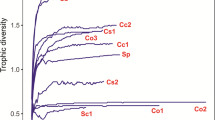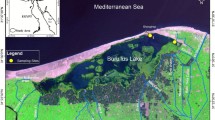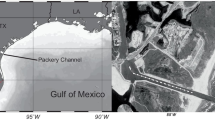Abstract
Gut fullness of larval fishes was used to determine the nutritional significance of an estuarine plume front off Botany Bay, SE Australia, on three days in March/April 1990. Fishes were captured in three different water masses (estuarine plume, front and shelf water), each separated by ≃ 200 m, using a 260 μm mesh purse-seine net. Overall, the gut-fullness index (GFI) of 260 fish larvae combined from eight families (Gerreidae, Mugilidae, Mullidae, Sparidae, Blenniidae, Kyphosidae, Monodactylidae, Pomacentridae), was significantly greater in the plume and front water on two of the sampling occasions, but no difference was detected on the third occasion. Trends in GFI among families were inconsistent with respect to the front. The mugilid (Liza argentea) fed equally and abundantly in all water masses (gut fullness>90%), while the kyphosid (Kyphosus spp.) had a significantly greater GFI in the plume compared to the shelf water. In general, the response of GFI to the front varied between dates and amongst taxa. Diet analysis showed that mugilids selected for copepod nauplii within the plume and shelf water [alpha selectivity index (ASI) of (0.22 to 0.98)] and for harpacticoid copepods within the front (ASI=0.92), representing characteristic diets identified by canonical discriminant analysis. Kyphosids selected positively for copepod nauplii in all three water masses on both occasions (ASI>0.96). In general, diets of larval fish were taxon-specific, and responded variably to the three habitats. Comparison of diets across water masses was complicated by the large number of families, which rarely occurred in all water masses. The nutritional significance of an estuarine plume front varies between species of larval fish, and there are no obvious trends that can be applied to the larval fish community in general.
Similar content being viewed by others

References
Abacus Concepts (1992) Statview. Abacus Concepts, Berkeley, California
Anderson JT (1994) Feeding ecology and condition of larval and pelagic juvenile redfish Sebastes spp. Mar Ecol Prog Ser 104: 211–226
Arthur DK (1976) Food and feeding of three fishes occurring in the Californian current, Sardinops sagax, Engraulis mordax and Trachurus symmetricus. Fish Bull US 74:517–530
Boehlert GW, Morgan JB (1985) Turbidity enhances feeding success of larval Pacific herring, Clupea harengus pallasi. Hydrobiologia 123:161–170
Breitburg DL (1988) Effects of turbidity on prey consumption by striped bass larvae. Trans Am Fish Soc 117:72–77
Chesson J (1978) Measuring preference in selective predation. Ecology 59:211–215
Ferron A, Leggett WC (1994) An appraisal of condition measures for marine fish larvae. Adv mar Biol 30:217–303
Frank KT (1992) Independent distributions of fish larvae and their prey: natural paradox or sampling artefact? Can J Fish aquat Sciences 45:48–59
Gaughan DJ (1991) Feeding by estuarine and marine fish larvae. In: Hancock DA (ed) Larval biology. Australian Government Printing Services, Canberra, pp 37–40
Govoni JJ, Chester AJ (1990) Diet composition of larval Leiostomus xanthurus in and about the Mississippi River plume. J Plankton Res 12:819–830
Govoni JJ, Grimes CB (1992) The surface accumulation of larval fishes by hydrodynamic convergence within the Mississippi River plume front. Contin Shelf Res 12:1265–1276
Govoni JJ, Hoss DE, Colby DR (1989) The spatial distribution of larval fishes about the Mississippi River plume. Limnol Oceanogr 34:178–187
Gray CA (1993) Horizontal and vertical trends in the distribution of larval fishes in coastal waters off central New South Wales, Australia. Mar Biol 116:649–666
Gray CA, Otway NM, Laurenson FA, Miskiewicz AG, Pethebridge RL (1992) Distribution and abundance of marine fish larvae in relation to effluent plumes from sewage outfalls and depth of water. Mar Biol 113:549–559
Grimes CB, Finucane JH (1991) Spatial distribution and abundance of larval and juvenile fish, chlorophyll and macroplankton around the Mississippi River discharge plume, and the role in the plume of fish recruitment. Mar Ecol Prog Ser 75:109–119
Hunter JR (1981) Feeding ecology and predation of marine fish larvae. In: Lasker R (ed) Marine fish larvae: morphology, ecology, and relation to fisheries. Washington Sea Grant Program, Seattle, pp 34–77
Jenkins GP (1987) Comparative diets, prey selection, and predatory impact of co-occurring larvae of two flounder species. J exp mar Biol Ecol 110:147–170
Jenkins GP, Milward NE, Hartwick RF (1984) Food of larvae of Spanish mackerels, genus Scomberomorus (Teleostei: Scombridae), in shelf waters of the Great Barrier Reef. Aus J mar Freshwat Res 35:477–512
Kingsford MJ, Choat JH (1986) Influence of surface slicks on the distribution and onshore movements of small fish. Mar Biol 91: 161–171
Kingsford MJ, Suthers IM (1994) Dynamic estuarine plumes and fronts: importance to small fish and plankton in coastal waters of NSW, Australia. Contin Shelf Res 14:655–672
Kingsford MJ, Suthers IM (1996) Tidal dynamics of an estuarine plume front and its larval fish community. Estuar, cstl Shelf Sci (in press)
Lasker R (1975) Field criteria for survival of anchovy larvae. The relation between inshore chlorophyll maximum layers and successful first feeding. Fish Bull US 73:453–462
Lasker R (1981) Factors contributing to variable recruitment of the northern anchovy (Engraulis mordax) in the Californian current: contrasting years, 1975 through 1978. Rapp P-v Réun Cons perm int Explor Mer 178:375–388
Martin FD, Wright DA (1987) Nutritional state analysis and its use in predicting striped bass recruitment: laboratory calibration. Am Fish Soc Symp 2:109–114
May RC (1974) Larval mortality in marine fishes and the critical period concept. In: Blaxter JHS (ed) The early life history of fish. Springer-Verlag, New York, pp 3–19
Miskiewicz AG (1989) Taxonomy and ecology of fish larvae in Lake Macquarie and New South Wales coastal waters. Ph.D. thesis. University of New South Wales, Sydney
Munk P (1993) Differential growth of larval sprat Sprattus sprattus across a tidal front in the eastern North Sea. Mar Ecol Prog Ser 99:17–27
Murdoch RC (1990) Diet of hoki larvae (Macruronus novaezelandiae) off Westland, New Zealand. NZ Jl mar Freshwat Res 24: 519–527
Powell AB, Chester AJ, Govoni JJ, Warlen SM (1990) Nutritional condition of spot larvae associated with the Mississippi River plume. Trans Am Fish Soc 1119:957–965
Schmitt PL (1986) Feeding by larvae of Hypoatherina tropicalis (Pisces: Atherinidae) and its relation to prey availability in One Tree Lagoon, Great Barrier Reef, Australia. Envir Biol Fish 16: 79–94
Shepherd JG, Cushing DH (1980) A mechanism for density-dependent survival of larval fish as the basis of a stock-recruitment relationship. J Cons int Explor Mer 39:160–167
Sundby S, Fossum P (1990) Feeding conditions of Arcto-Norwegian cod larvae compared to the Rothschild-Osborn theory on small scale turbulence and plankton contact rates. J Plankton Res 12: 1153–1162
Thresher RE, Nichols PD, Gunn JS, Bruce BD, Furlani DM (1992) Evidence of seagrass detritus as the basis of a coastal planktonic food chain. Limn Oceanol 37:1754–1758
Tully O, O'Ceidigh P (1989) The ichthyoneuston of Galway Bay (west of Ireland). II. Food of post-larval and juvenile neustonic fish. Mar Ecol Prog Ser 51:301–310
Whitfield AK (1989) Ichthyoplankton interchange in the mouth region of a southern African estuary. Mar Ecol Prog Ser 54: 25–33
Young JW (1991) Feeding ecology of marine fish larvae: an Australian perspective. In: Hancock DA (ed) Larval biology. Australian Government Printing Services, Canberra, pp 30–36
Young JW, Davis TLO (1990) Feeding ecology of larvae of southern bluefin, albacore and skipjack tunas (Pisces: Scombridae) in the eastern Indian Ocean. Mar Ecol Prog Ser 61: 17–29
Young JW, Davis TLO (1992) Feeding ecology and interannual variations in diet of larval jack mackerel, Trachurus declivis (Pisces: Carangidae), from coastal waters of eastern Tasmania. Mar Biol 113:11–20
Author information
Authors and Affiliations
Additional information
Communicated by G.F. Humphrey, Sydney
Rights and permissions
About this article
Cite this article
Rissik, D., Suthers, I.M. Feeding in a larval fish assemblage: the nutritional significance of an estuarine plume front. Marine Biology 125, 233–240 (1996). https://doi.org/10.1007/BF00346303
Received:
Accepted:
Issue Date:
DOI: https://doi.org/10.1007/BF00346303



